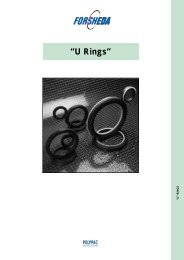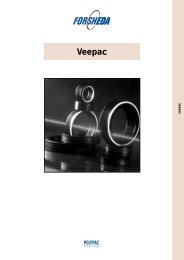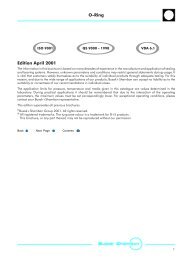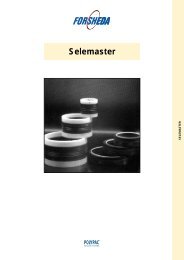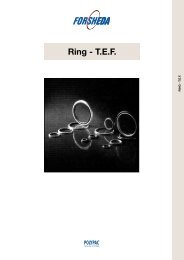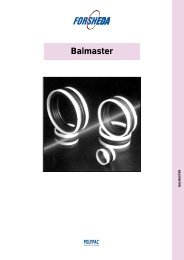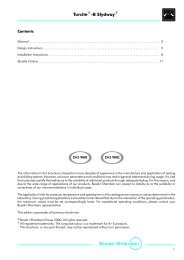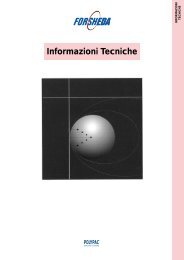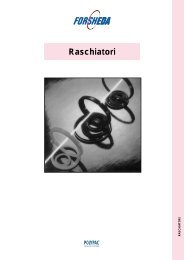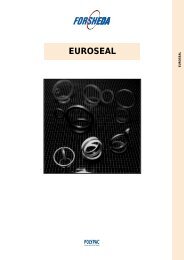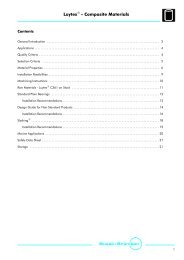Rotary Seals - Dilanda.it
Rotary Seals - Dilanda.it
Rotary Seals - Dilanda.it
Create successful ePaper yourself
Turn your PDF publications into a flip-book with our unique Google optimized e-Paper software.
V—Ring<br />
recommended to arrange an axial support, especially for<br />
small cross-section profiles and larger shaft sizes, for<br />
example V—Ring type A, L and LX.<br />
The surface roughness of the shaft should in general not<br />
exceed Ra 6.3 μm. For sealing fluids and fine particles, a<br />
maximum of Ra 3.2 μm is recommended. Sharp edges and<br />
burrs, which can damage the V—Ring must be avoided.<br />
Counter-face design<br />
The cond<strong>it</strong>ion of the counter-face has a great influence on<br />
the sealing function. The medium to be sealed and the<br />
peripheral speed of the shaft determine the requirements<br />
regarding surface roughness and material of the counterface.<br />
It is important that <strong>it</strong> is smooth and flat w<strong>it</strong>hout any<br />
sharp edges. To achieve the full effect of the flinger action,<br />
the V—Ring should always be designed in a relatively open<br />
space. Equally important is to keep the gap between the<br />
shaft and the counter-face as small as possible, in order to<br />
prevent entry of the V—Ring lip during the installation.<br />
Recommended application dimensions are given in the<br />
dimension tables.<br />
Material and material hardness<br />
Cold rolled steel sheet, stainless steel or zinc plated sheet<br />
are excellent materials for the counter-face. However, the<br />
choice of material is highly dependent on the medium to<br />
be sealed.<br />
For normal running cond<strong>it</strong>ions, conventional mild steel<br />
w<strong>it</strong>h a hardness of min. 125 HB is sufficient. For sealing<br />
against grease, oil and dry particles no further surface<br />
treatment is required. W<strong>it</strong>h an increase in speed and the<br />
presence of abrasive particles the hardness of the counterface<br />
must also be increased.<br />
The following materials are normally used :<br />
Material Hardness HB Medium<br />
Mild Steel 125-150 Water splash, sand,<br />
dust<br />
Grey Cast Iron 190-270 Water splash, sand,<br />
dust<br />
Sinter Bronze 100-160 Water, dust<br />
Stainless Steel 150-200 Water<br />
(Cr/Ni 18-8, C 0.1%)<br />
Stainless Steel<br />
(Cr/Ni 18-8, C 0.15%)<br />
Work-hardened<br />
350 Water and abrasive<br />
particles<br />
Acid Proof Steel 180-200 Chemicals<br />
Tungsten Carbide 350-500 Water and scale<br />
Forged Steel 200-255 Water and scale<br />
Die-cast Aluminium 90-160 Water splash<br />
Surface treatment<br />
When the counter-face is exposed to water or other<br />
corrosive media, <strong>it</strong> must be protected accordingly.<br />
Mild steel surfaces should e<strong>it</strong>her be zinc-plated and<br />
chromated, chromium plated, treated w<strong>it</strong>h an<br />
anticorrosion spray, or painted. The choice of treatment<br />
will depend on the overall running cond<strong>it</strong>ions.<br />
Where the seal is immersed in water, stainless steel is<br />
recommended. However, due to the poor thermal<br />
conductiv<strong>it</strong>y stainless steel should not be used in dry<br />
running cond<strong>it</strong>ions unless the speed is slow ( 10 Oil, water, scale, fibre<br />
0.8-1.6 5-10 Oil splash, grease,<br />
water splash<br />
1.6-2.0 1-5 Grease, dust, water<br />
splash, scale<br />
2.0-2.5



